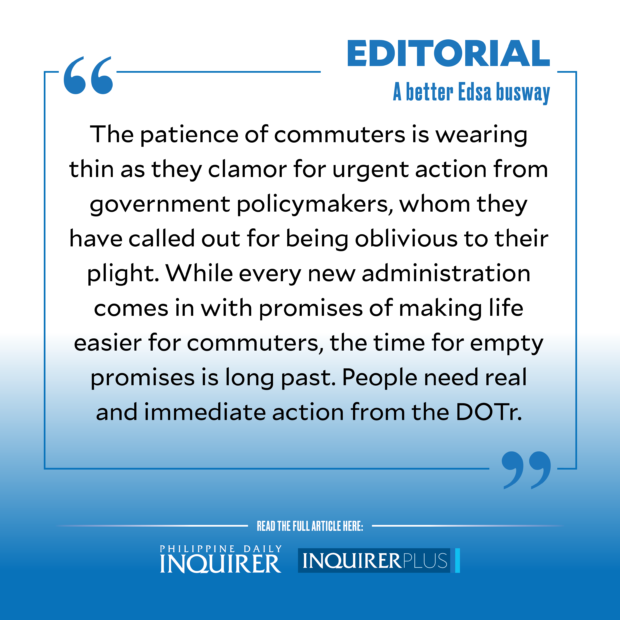A better Edsa busway
The surge in the volume of commuters after the loosening of COVID-19 restrictions and the resumption of face-to-face classes has overwhelmed the already thinly stretched busway system on Edsa, turning up the pressure on Department of Transportation (DOTr) Secretary Jaime Bautista to take immediate and effective steps to resolve this perennial problem.
Bautista, whose expertise is in air transportation having spent years at the helm of Philippine Airlines, conceded early on that he doesn’t “know much of problems in land transportation.” But that has not prevented him from riding the Metro Rail Transit (MRT) to personally experience the “unacceptable” commuter situation that has long been a favorite object of social media anger.
The private sector has been as proactive, with the Management Association of the Philippines (MAP) suggesting in an Aug. 9 letter to Bautista the need to privatize the Edsa busway and bus service on the “carousel line” under a so-called hybrid mode. That means the government will provide the infrastructure and its improvements, while private concessionaires will operate and maintain the rolling stock or trains and the stations, including the fare ticketing system. This, the MAP said, would push the public transportation system on Edsa, the country’s busiest thoroughfare, closer to global standards.
“We are prepared to work with the DOTr and other private sector stakeholders in preparing the terms of reference for the bidding and award of the concessions,” said the letter signed by MAP president Rogelio L. Singson and MAP infrastructure committee chair Eduardo Yap.
The Edsa busway, located on the innermost lanes, was introduced by former transportation secretary Arturo Tugade on June 1, 2020, to replace the yellow lanes. Billed then as the solution to the horrendous pre-pandemic traffic jams on Edsa, the busway functions as an expressway for buses to run unimpeded by traffic congestion. The public buses run on a “carousel line” or a single loop route that runs from Monumento in the north to the Parañaque Integrated Terminal in the south.
Unfortunately, the carousel line and busway are not operating as efficiently as they should, as there are still many uncompleted components even after two years since they were introduced. As a result, the busway system has been stretched to breaking point with the swarm of commuters and the lack of accredited buses to service them.
The MAP noted that another major contributory factor to the chaos along the carousel line is that the MRT 3 stations on Edsa and their access stairs are doing double duty, servicing both the bus and train passengers. That means the stations are bursting at the seams with the deluge of daily commuters, including office workers and students, now that work-from-home arrangements and online classes are no longer necessary.
Add to this the government’s Libreng Sakay program that has been extended until the end of the year, and you have a “grossly distorted demand [that has] exerted pressure on the busway system beyond its present limited capacity,” said the MAP. “Compounding the problem is the inadequate supply and infrequent arrival of buses,” the group added.
More importantly, the busway is extremely inconvenient for commuters who have to endure climbing steep footbridges to access the busway in the middle of Edsa. Elvira Medina, chair of the advocacy group National Center for Commuter Safety and Protection (NCCSP) pointed out that the busway is risky and challenging, particularly for seniors and persons with disabilities who have difficulties climbing the footbridges.
Not all are thrilled, however, about the prospect of the private sector taking over the operation of the Edsa busway and the carousel line service.
For while the private entities’ deep pockets can lead to a markedly improved service, it will almost certainly come at a higher cost. The NCCSP has expressed concern as well about the individuals or groups that will be awarded the government contracts.
Given these legitimate concerns, it is understandable and even expected that the DOTr would carefully deliberate on the various proposals being pushed from all sides. This, however, should not excuse the agency from implementing quick solutions to ease the commuters’ pain.
The DOTr can also take up the MAP’s suggestion to expedite the construction of footbridges to resolve the choke points at MRT stations and provide easier bus-to-train connectivity. It can also immediately work with the Swedish government, which offered to help dramatically improve the dire situation along the highly patronized Edsa busway project.
The patience of commuters is wearing thin as they clamor for urgent action from government policymakers, whom they have called out for being oblivious to their plight. While every new administration comes in with promises of making life easier for commuters, the time for empty promises is long past. People need real and immediate action from the DOTr. Hopefully, Bautista would respond expeditiously to that clarion call.





















